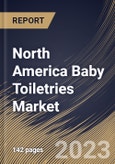Baby toiletries witnessed increasing adoption due to increasing hygiene care for babies, a rise in birth rate, and a surge in customers' disposable income. The increase in the number of working women ratio and improvements in people's living standards in emerging economies create numerous opportunities in the market. An increased understanding of the benefits of baby products like diapers, baby wipes, and tissues drives the expansion of the market. However, the presence of toxic chemicals in baby toiletries products, like phthalates and formaldehyde in shampoos and lotions, hinders the growth of the market. These products have harmful effects on children and can cause skin allergies and even asthma. Many ingredients used in baby wipes are contaminated with formaldehyde, a harmful ingredient that severely affecting the body.
Rising parental concerns about infant skin drive the growth of baby skin care products. Moreover, the skin of infants is generally delicate, and therefore, it needs to be protected from exposure to dirt. People are most likely to prefer skin care products owing to increasing awareness regarding hygiene and the overall health of babies. Moreover, kids are more prone to catching chronic diseases and attract bacteria that lead to diseases. Many companies have developed innovative ideas to showcase the importance of hygiene in babies and how this can affect their health.
According to Statistics Canada, the share of retail e-commerce sales, as a ratio of total retail sales, increased from 3.9% in 2019 to 6.2% in 2022 (July year to date). During the peak of the pandemic in 2020 and 2021, the shares of retail e-commerce sales were 6.6% and 6.9%, respectively. E-commerce allows parents to shop for baby toiletries from the comfort of their homes. This accessibility is particularly beneficial for busy parents, allowing them to browse, compare, and purchase products easily. Consumers can easily compare prices and find discounts or promotions on e-commerce platforms. This transparency in pricing encourages competitive pricing among brands and creates opportunities for cost-conscious parents to find value in their baby toiletry purchases. These aspects will boost the market growth in the coming years.
The US market dominated the North America Baby Toiletries Market, By Country in 2022, and would continue to be a dominant market till 2030; thereby, achieving a market value of $27,264.8 million by 2030. The Canada market is experiencing a CAGR of 8% during (2023 - 2030). Additionally, The Mexico market would exhibit a CAGR of 7.1% during (2023 - 2030).
Based on Mode of Sale, the market is segmented into Offline, and Online. Based on Product Type, the market is segmented into Baby Diapers (Disposable, Reusable), Skin Care Products, Hair Care Products, Baby Wipes, and Others. Based on End User, the market is segmented into Toddlers, Infants, and New Borne. Based on countries, the market is segmented into U.S., Mexico, Canada, and Rest of North America.
The market research report covers the analysis of key stake holders of the market. Key companies profiled in the report include Reckitt Benckiser Group PLC, California Baby, Artsana S.p.A., Johnson & Johnson, The Procter & Gamble Company, Kimberly-Clark Corporation, Svenska Cellulosa Aktiebolaget SCA, Beiersdorf AG, Weleda AG, Cotton Babies, Inc.
Scope of the Study
Market Segments Covered in the Report:
By Mode of Sale (Volume, Million Units, USD Billion, 2019-2030)- Offline
- Online
- Baby Diapers
- Disposable
- Reusable
- Skin Care Products
- Hair Care Products
- Baby Wipes
- Others
- Toddlers
- Infants
- New Borne
- US
- Canada
- Mexico
- Rest of North America
Key Market Players
List of Companies Profiled in the Report:
- Reckitt Benckiser Group PLC
- California Baby
- Artsana S.p.A.
- Johnson & Johnson
- The Procter & Gamble Company
- Kimberly-Clark Corporation
- Svenska Cellulosa Aktiebolaget SCA
- Beiersdorf AG
- Weleda AG
- Cotton Babies, Inc.
Unique Offerings
- Exhaustive coverage
- The highest number of Market tables and figures
- Subscription-based model available
- Guaranteed best price
- Assured post sales research support with 10% customization free
Table of Contents
Companies Mentioned
- Reckitt Benckiser Group PLC
- California Baby
- Artsana S.p.A.
- Johnson & Johnson
- The Procter & Gamble Company
- Kimberly-Clark Corporation
- Svenska Cellulosa Aktiebolaget SCA
- Beiersdorf AG
- Weleda AG
- Cotton Babies, Inc.








